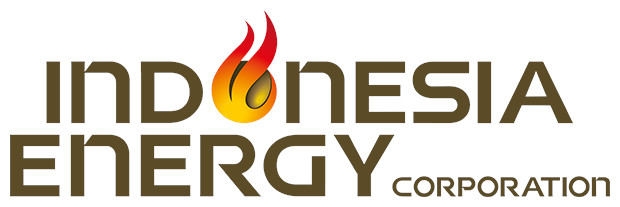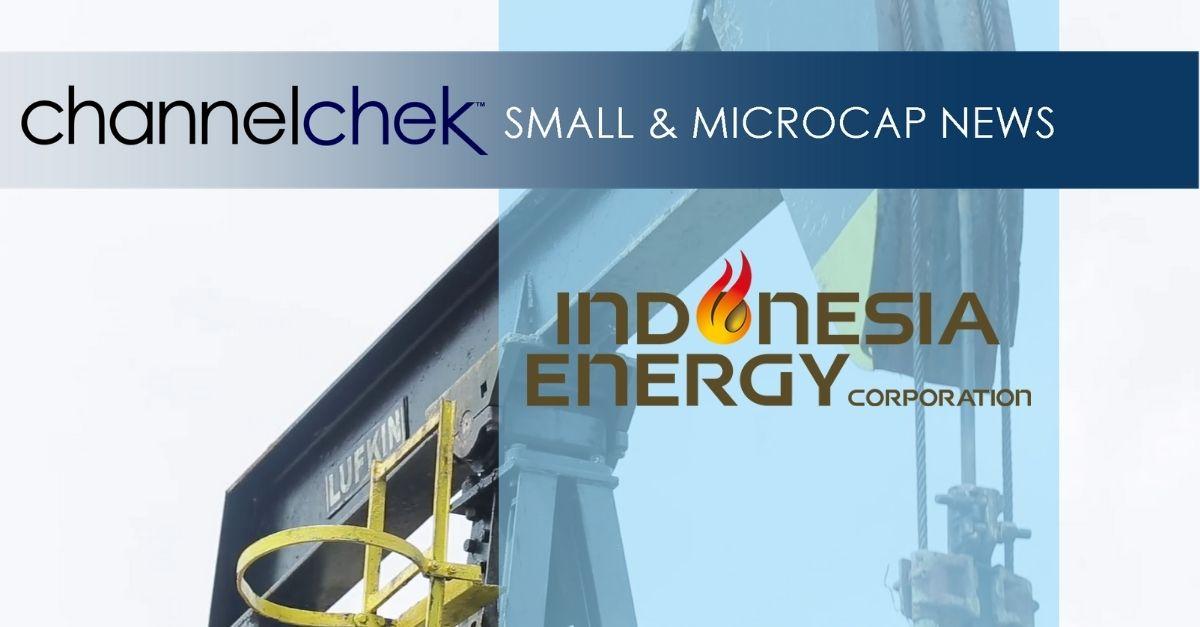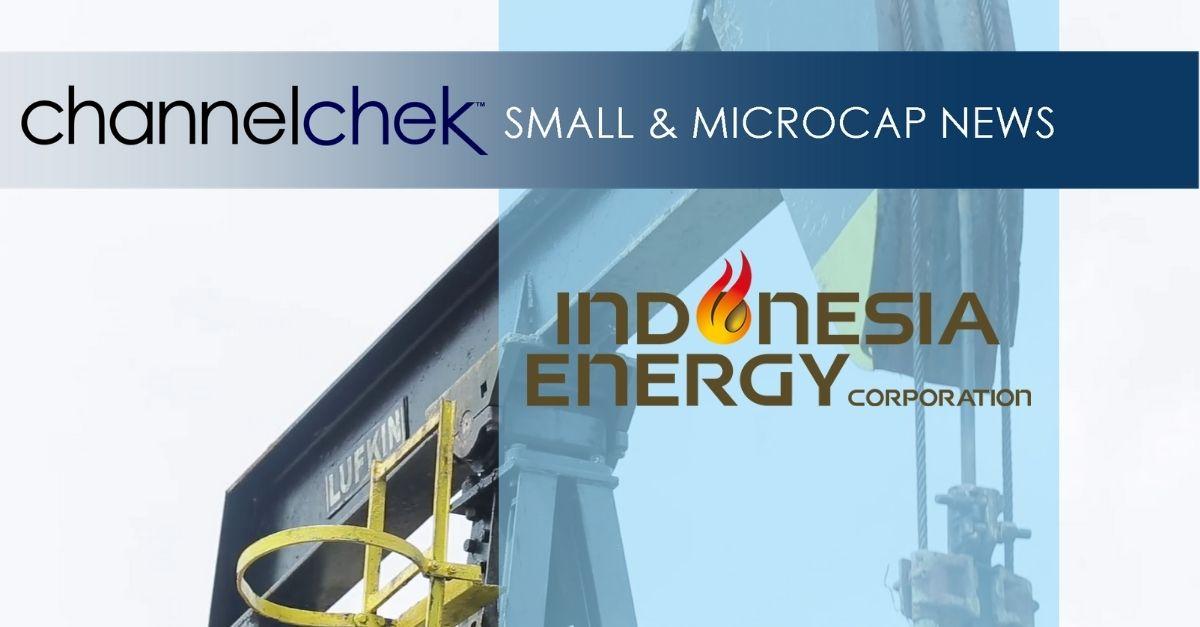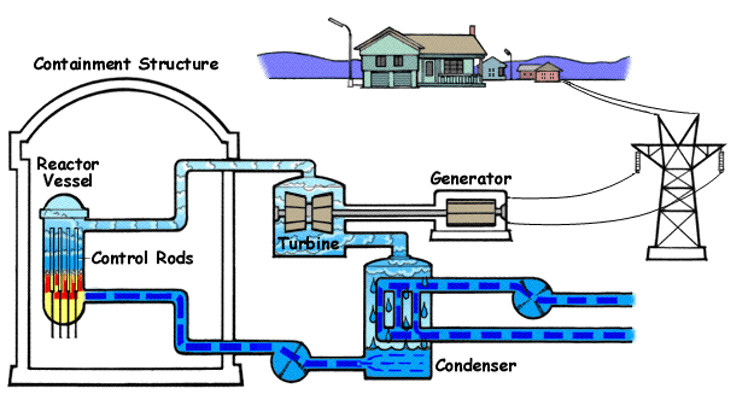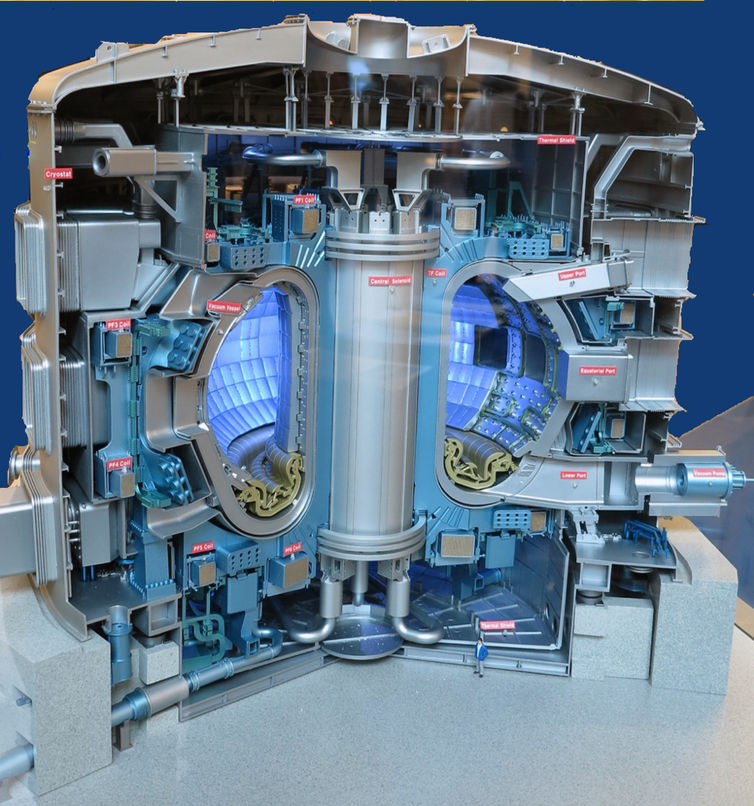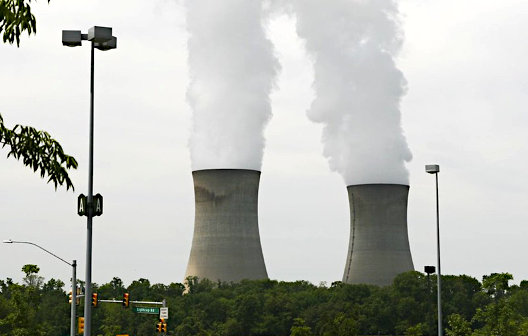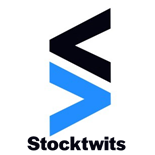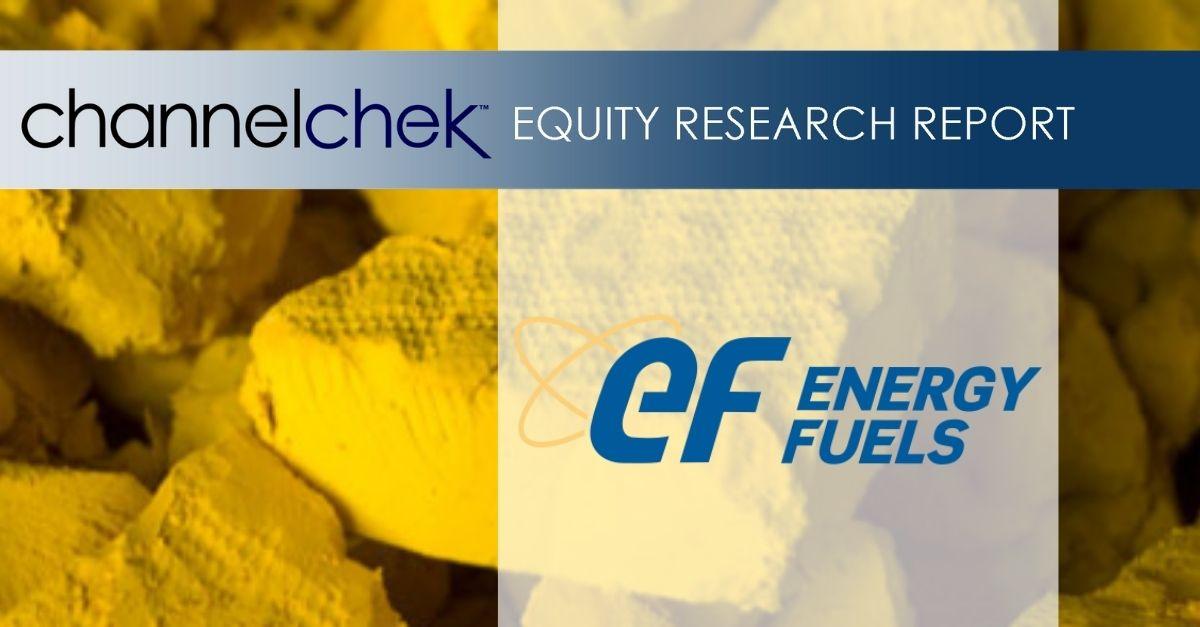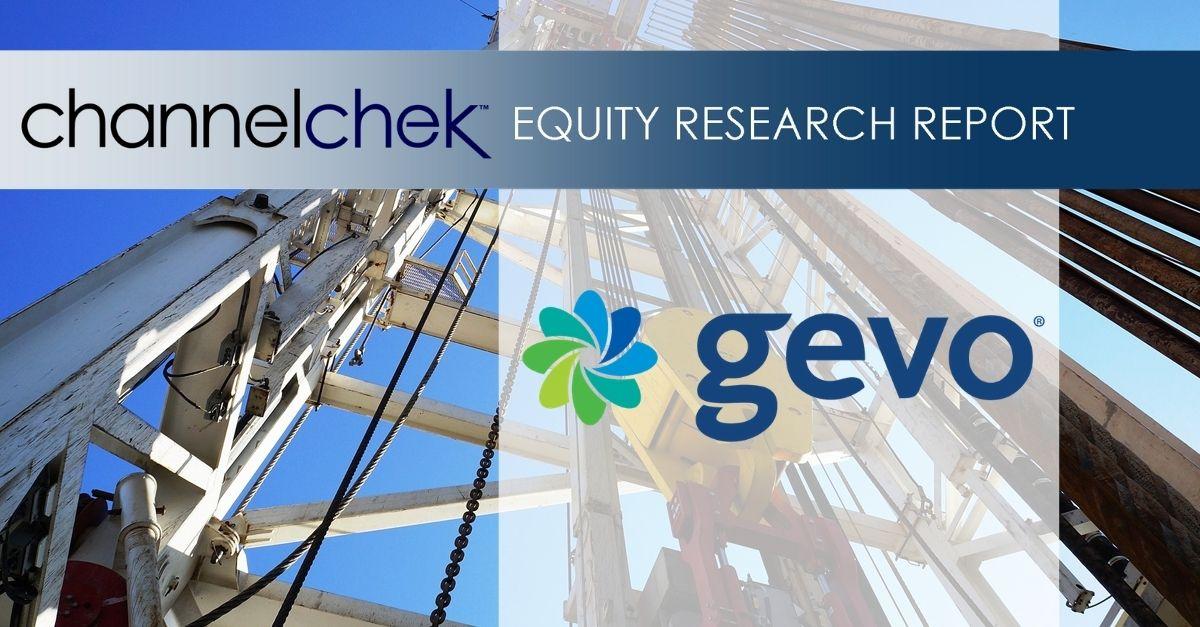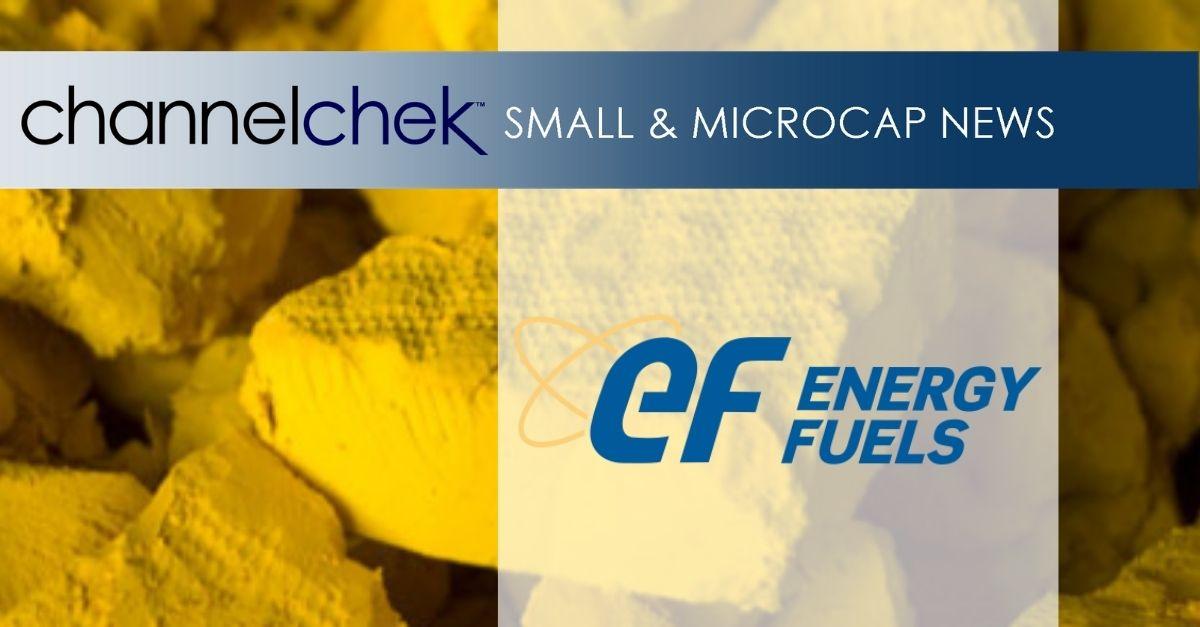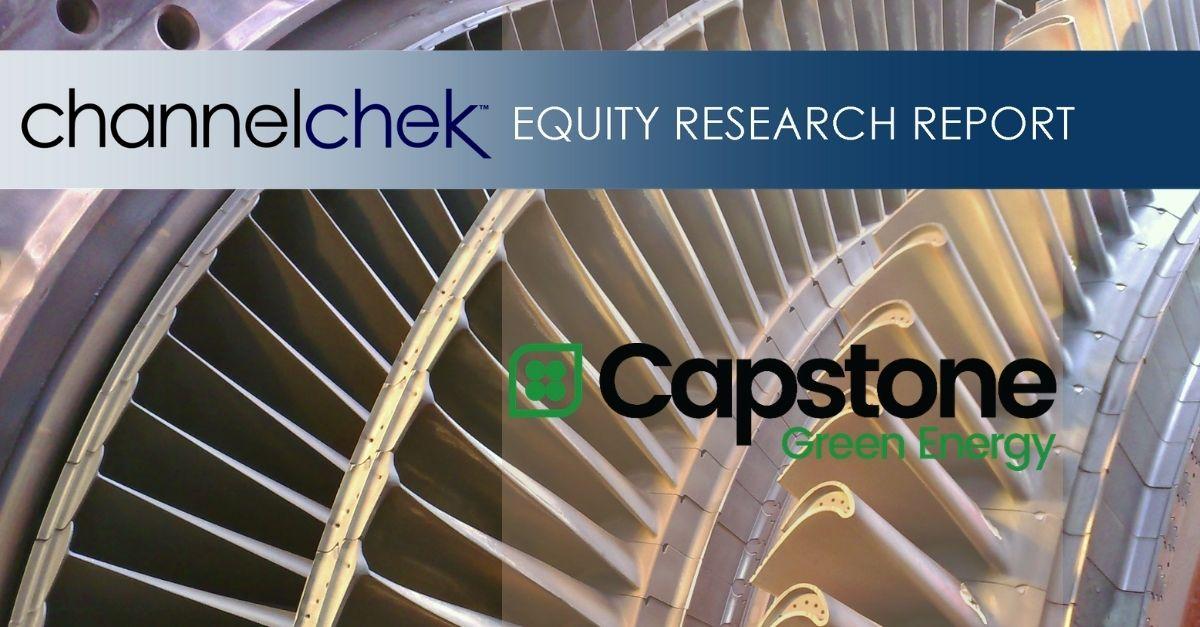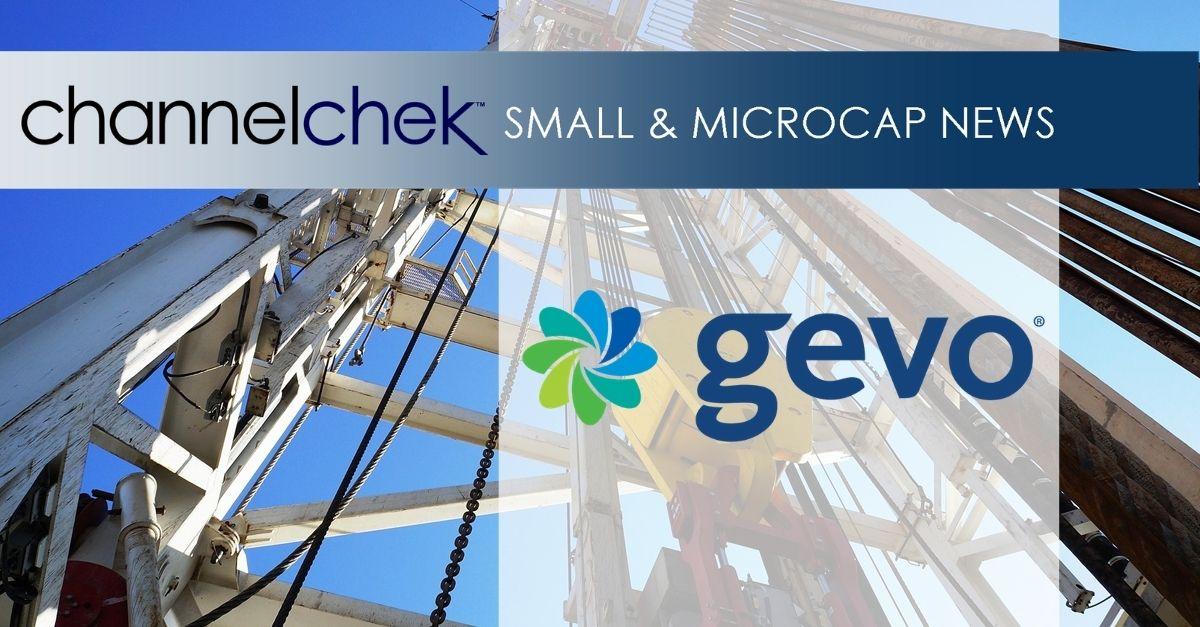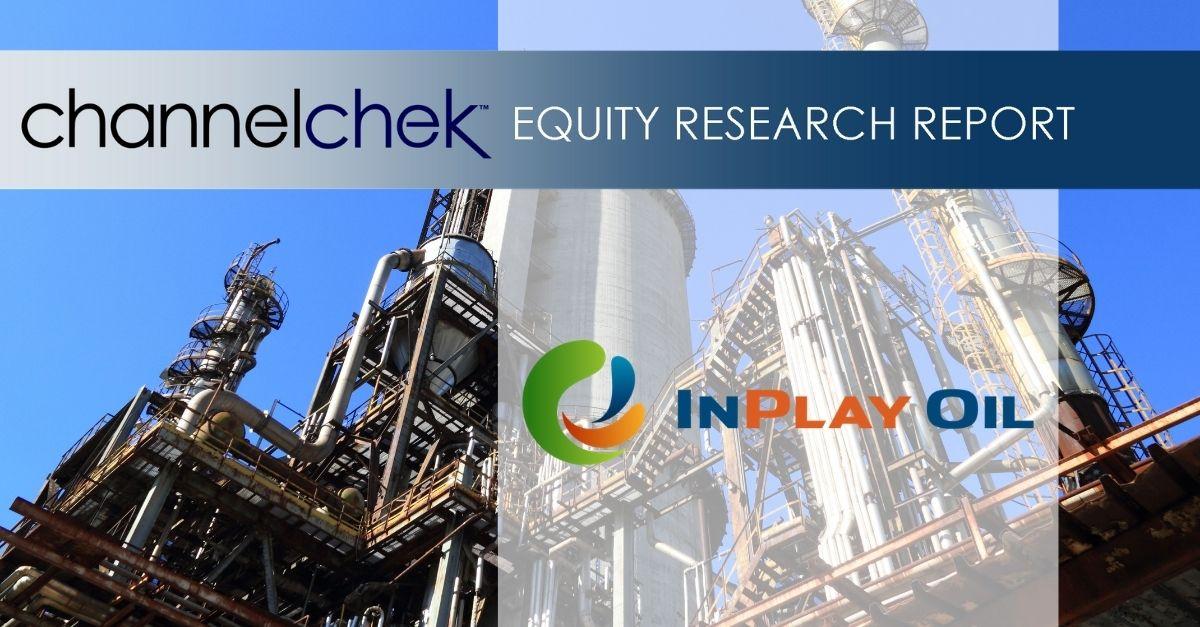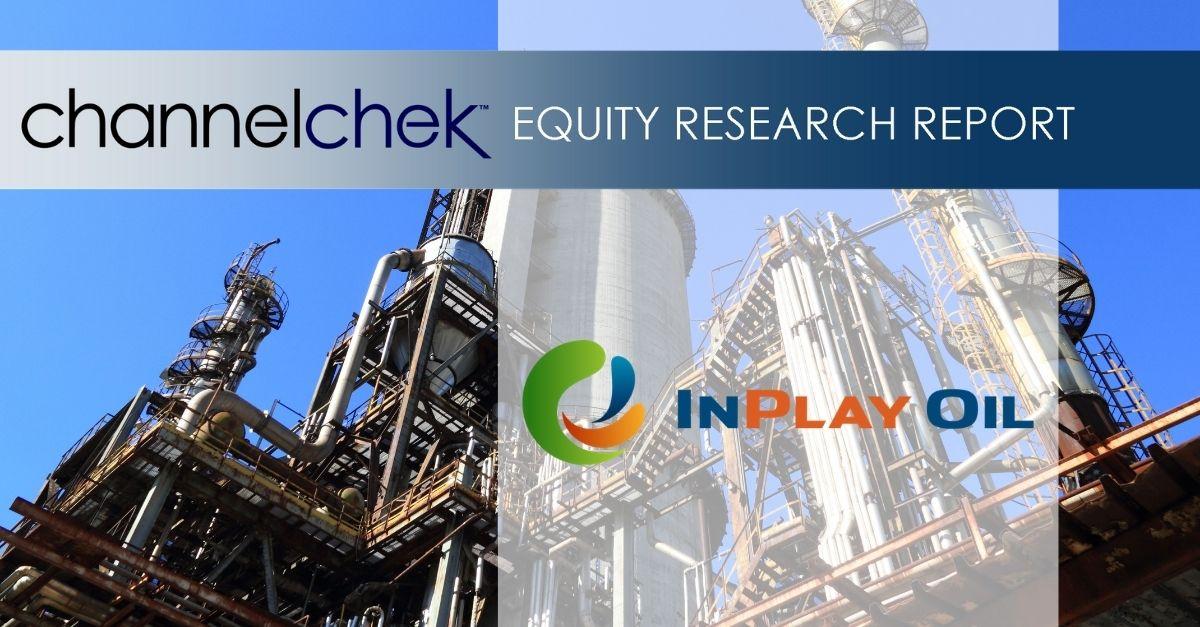LAKEWOOD, Colo., May 13, 2021 /CNW/ – Energy Fuels Inc. (NYSE American: UUUU) (TSX: EFR) (“Energy Fuels” or the “Company”) today reported its financial results for the quarter ended March 31, 2021. The Company’s annual report on Form 10-K has been filed with the U.S. Securities and Exchange Commission (“SEC“) and may be viewed on the Electronic Document Gathering and Retrieval System (“EDGAR“) at www.sec.gov/edgar.shtml, on the System for Electronic Document Analysis and Retrieval (“SEDAR“) at www.sedar.com, and on the Company’s website at www.energyfuels.com. Unless noted otherwise, all dollar amounts are in U.S. dollars.
Highlights:
- At March 31, 2021, the Company had $60.37 million of working capital, including $44.11 million of cash and marketable securities and $27.98 million of inventory, including approximately 690,800 pounds of uranium and 1,672,000 pounds of high-purity vanadium in the form of immediately marketable product.
- Due to recent share price strength, the Company raised gross proceeds of $12.99 million on its at-the-market equity program between April 1, 2021 and May 12, 2021, further enhancing the Company’s financial position.
- During the quarter ended March 31, 2021, the Company incurred a net loss of $10.91 million, compared to a net loss of $5.66 million for the first quarter of 2020, due primarily to an increase in the Company’s share price during Q1 2021, which resulted in a non-cash mark-to-market increase in warrant liabilities of $3.50 million during Q1 2021, and an increase of $2.69 million in development expenditures in Q1 2021 compared to Q1 2020 primarily due to the development and ramping up of the expected rare earth element (“REE“) carbonate production program at the White Mesa Mill during the first quarter of 2021.
- With several existing mines on standby and existing inventories of Company-produced, U.S.-origin uranium, the Company continues to be ready to supply uranium into the U.S. Uranium Reserve once it is established by the U.S. government.
- On March 1, 2020, the Company, along with Neo Performance Materials (“Neo“), announced the joint launch of a U.S.-European REE production initiative under which the parties plan to produce value-added REE products from natural monazite sands, a byproduct of heavy mineral sands mined in the southeastern United States. Pursuant to this initiative, in late-March 2021 Energy Fuels commenced ramping-up commercial production of a mixed rare earth carbonate (“REE Carbonate“) from natural monazite sands at the Company’s White Mesa Mill. Under an agreement in principle signed on March 1, and subject to completion of definitive agreements and successful ramp-up of production, Energy Fuels will ship a portion of its REE Carbonate production to Neo’s REE separations facility in Sillamae, Estonia (“Silmet“). Neo will then process the REE Carbonate into separated REE materials for use in REE permanent magnets and other REE-based advanced materials.
- On March 9, 2021, the Company announced that the first shipments of natural monazite ore arrived at the Company’s White Mesa Mill from The Chemours Company’s Offerman Plant in Georgia, pursuant to a supply agreement entered into by the Company and Chemours in December 2020.
- On April 21, 2021, the Company announced the execution of a non-binding memorandum of understanding for the potential future supply of additional natural monazite sands from the Titan heavy mineral sand project in Tennessee owned by Hyperion Metals Limited.
- On April 23, 2021, the Company announced that the U.S. Department of Energy (“DOE“) Office of Fossil Energy and National Energy Technology Laboratory exercised an option to award Energy Fuels, working with a team from Penn State University, an additional $1.75 million to complete a feasibility study on the production of REE products from natural coal-based resources, as well as from other materials such as REE-containing ores like the natural monazite ore the Company is currently processing at the White Mesa Mill.
- On April 27, 2021, the Company announced that it engaged Carester SAS (“Carester“) to prepare a scoping study for the development of a solvent extraction (“SX“) REE separation circuit at the White Mesa Mill. Carester is one of the world’s leading global consultants on REE supply chains, with expertise in designing, constructing, operating and optimizing REE production facilities globally.
Mark S. Chalmers, Energy Fuels’ President and CEO, stated:
“Without a doubt, Energy Fuels is making major strides toward restoring critical U.S. rare earth supply chains, while also maintaining our position as the leading U.S. uranium producer,” stated Mark S. Chalmers, President and CEO of Energy Fuels. “On rare earths, our efforts over the past several months culminated in the announcement on March 1 that Energy Fuels and Neo Performance Materials were creating a new, U.S.-European rare earth supply chain. In early March, we began to receive shipments of rare-earth-rich natural monazite sands from Chemours’ Georgia heavy mineral sand operations. In late-March, we began to ramp-up production of an intermediate rare earth product at our White Mesa Mill in Utah using monazite from Chemours. This is expected to be a high-value product ready to be separated and refined into value-added rare earth products at Neo’s plant in Europe. At this time, no other U.S. company is producing a product this far down the rare earth value chain.
“However, as I’ve said many times, we have much bigger rare earth plans, and the momentum is building rapidly as we execute our purposeful strategy. We are now taking real steps toward designing and building fully integrated, U.S. rare earth production capabilities. To this end, we hired Carester SAS of Lyons, France, one of the world’s leading rare earth supply chain experts, to help us begin designing rare earth separation capabilities at the White Mesa Mill. And we are continuing several collaborations with the U.S. government and national laboratories on various rare earth initiatives, including being granted a $1.75 million contract by the U.S. Department of Energy to perform studies that complement our work to develop rare earth separation capabilities at the White Mesa Mill. We continue to believe Energy Fuels has distinct advantages in the rare earth sector. Monazite ore has superior distributions of the high-value magnetic rare earths, including NdPr and “heavy” rare earths, versus most other rare earth minerals mined around the world, and monazite is currently produced as a byproduct of existing heavy mineral sand operations. We are also taking steps to utilize licensed and existing facilities at the White Mesa Mill to process the monazite into value-added products. This is a highly capital efficient initiative.
“While we are obviously extremely excited about the potential for rare earths, our core business remains uranium production, and by almost any metric, including a successful track-record of past and current uranium production, experience in both ISR and conventional uranium mining, existing licensed and constructed processing capacity, U.S.-origin inventory, recycling capabilities, and the like, Energy Fuels is clearly the leading U.S. uranium company as well. We are particularly excited by actions the Biden Administration is taking to address climate change and support nuclear energy. The U.S. gets 20% of all of our electricity, and 55% of our carbon-free electricity, from nuclear. Meeting the President’s climate goals will require preserving America’s existing fleet of nuclear reactors, while quickly deploying the next generation of reactors. And global policies, including those in Europe and China, are supporting nuclear power to achieve carbon reduction goals. We remain ready to supply U.S.-origin uranium for these initiatives.
“At the same time, we are transforming our company into ‘America’s Critical Mineral Hub’, with the main focus being on the White Mesa Mill in Utah. While nearly all current and future nuclear reactors are fueled by uranium, other clean energy and advanced technologies, including electric vehicles renewable energy and batteries, require other critical minerals that Energy Fuels produces. A robust market for responsibly produced, American clean energy products and technologies, made by American workers, is possible in the U.S. How amazing would it be for electric vehicles to be built in America using rare earth products manufactured in America; and for those EVs to be charged using carbon-free, next generation American nuclear technologies fueled by American uranium and nuclear fuel, along with renewable energy systems using American rare earth products? Energy Fuels’ White Mesa Mill in Utah can help this vision become a reality. To say these are exciting times for our company would be the understatement of my lifetime.”
Webcast on Monday, May 17, 2021 at 4:00 pm ET (2:00 pm MT):
Energy Fuels will be hosting a video webcast Monday, May 17, 2021 at 4:00 pm ET (2:00 pm MT) to discuss its Q1-2021 financial results and corporate initiatives. To join the webcast, please click on the link below to access the presentation and the viewer-controlled webcast slides:
Energy Fuels’ Q1-2021 Results
If you would like to participate in the webcast and ask questions, please dial (888) 664-6392 (toll free in the U.S. and Canada).
A link to a recorded version of the proceedings will be available on the Company’s website shortly after the webcast by calling (888) 390-0541 (toll free in the U.S. and Canada) and by entering the code 764688#. The recording will be available until May 31 ,2021.
Selected Summary Financial Information:
|
|
|
|
$000’s, except per share data
|
Three months ended
March 31, 2021
|
Three months ended
March 31, 2020
|
|
Total revenues
|
$
|
353
|
$
|
393
|
|
Gross profit (loss)
|
353
|
(685)
|
|
Operating loss
|
(8,847)
|
(7,806)
|
|
Net loss attributable to the company
|
(10,908)
|
(5,657)
|
|
Basic and diluted loss per share
|
(0.08)
|
(0.05)
|
|
As at March 31,
2021
|
As at December 31,
2020
|
|
Financial Position:
|
|
|
|
Working capital
|
$
|
60,365
|
$
|
40,158
|
|
Property, plant and equipment, net
|
23,457
|
23,621
|
|
Mineral properties, net
|
83,539
|
83,539
|
|
Total assets
|
207,219
|
183,236
|
|
Total long-term liabilities
|
13,581
|
13,376
|
Operations Update and Outlook for the Quarter Ending March 31, 2021:
Overview
In response to the proposed establishment of a strategic national U.S. Uranium Reserve program, the Company is evaluating activities aimed towards increasing uranium production at all or some of our production facilities, including the currently operating White Mesa Mill, as well as the Alta Mesa ISR Facility, the Nichols Ranch ISR Facility, the La Sal Complex and Pinyon Plain Mine, which are currently on standby.
During 2021, the Company expects to recover uranium at the White Mesa Mill from pond-returns and from alternate feed materials. The Company also expects to recover uranium and produce mixed REE carbonate from natural monazite ore during 2021, subject to successful ramp-up. The vanadium pond-return campaign that was conducted in 2019 was brought to a close in early 2020. The Company does not plan to extract and/or recover any amounts of uranium of any significance from its Nichols Ranch Project in 2021, which was placed on standby in the second quarter of 2020 due to the depletion of its existing wellfields. Uranium recovery is expected to be maintained at reduced levels, as a result of current uranium market conditions, until such time when market conditions improve sufficiently.
The Company is also seeking new sources of revenue, including its emerging REE business, as well as new sources of alternate feed materials and new fee processing opportunities at the White Mesa Mill that can be processed under existing market conditions (i.e., without reliance on current uranium sales prices). The Company will also continue its support of U.S. governmental activities to support the U.S. uranium mining industry, including the proposed establishment of a U.S. Uranium Reserve. In addition, the Company is in discussions to potentially sell certain of its non-core properties, although there are currently no binding offers, and there can be no assurance that a sale will be completed or that we will be successful in completing a sale on acceptable terms.
Extraction and Recovery Activities Overview
During the quarter ended March 31, 2021, the Company did not recover significant quantities of U3O8. The Company expects to recover approximately 30,000 to 60,000 pounds of U3O8 in the year ending December 31, 2021 for its own account. In 2021, the Company also expects to produce approximately 2,000 to 3,000 tons of mixed REE carbonate at the mill, containing approximately 1,000 to 1,600 tons of total rare earth oxides (“TREO“). The Company expects to produce no vanadium during 2021.
The Company has strategically opted not to enter into any uranium sales commitments for 2021. Therefore, subject to the proposed establishment of a U.S. Uranium Reserve and general market conditions, all 2021 uranium production is expected to be added to existing inventories, which inventories are expected to total approximately 720,000 to 750,000 pounds of U3O8 at year-end. Subject to any actions the Company may take in response to the proposed establishment of a U.S. Uranium Reserve or improvements in general market conditions, both ISR and conventional uranium extraction and/or recovery is expected to continue to be maintained at reduced levels until such time that improvements in uranium market conditions are observed or suitable sales contracts can be entered into. All V2O5 inventory is expected to be sold on the spot market if prices rise sufficiently above current levels, but otherwise maintained in inventory. The Company expects to sell all or a portion of its mixed REE carbonate to global separation facilities and/or to stockpile it for future separation at the Mill or elsewhere.
ISR Activities
The Company expects to produce insignificant quantities of U3O8 in the year ending December 31, 2021 from Nichols Ranch.
Until such time as improvement in uranium market conditions is observed, the proposed U.S. Uranium Reserve is established, and/or suitable sales contracts can be procured, the Company expects to maintain the Nichols Ranch Project on standby and defer development of further wellfields and header houses. The Company currently holds 34 fully permitted, undeveloped wellfields at Nichols Ranch, including four additional wellfields at the Nichols Ranch wellfields, 22 wellfields at the adjacent Jane Dough wellfields, and eight wellfields at the Hank Project, which is fully permitted to be constructed as a satellite facility to the Nichols Ranch Plant.
The Company expects to continue to keep the Alta Mesa Project on standby until such time as improvements in uranium market conditions are observed, the proposed U.S. Uranium Reserve is established, and/or suitable sales contracts can be procured.
Conventional Activities Conventional Extraction and Recovery Activities
During the quarter ended March 31, 2021, the White Mesa Mill did not recover any quantities of U3O8, focusing instead on developing its REE recovery business. However, during the remainder of 2021, the Company expects to recover approximately 30,000 to 60,000 pounds of U3O8 at the White Mesa Mill, including uranium recovered through the processing of REE- and uranium-bearing natural monazite ore. The Company also expects to produce approximately 2,000 to 3,000 tons of mixed REE carbonate at the Mill, containing approximately 1,000 to 1,600 tons TREO. The Company currently has approximately 150,000 pounds of U3O8 contained in stockpiled alternate feed material and ore inventory that can be recovered in the future for the proposed U.S. Uranium Reserve or as general market conditions warrant. In addition, there remains an estimated 1.5-3 million pounds of solubilized recoverable V2O5 inventory remaining in the Mill’s tailings facility awaiting future recovery, as market conditions may warrant.
Conventional Standby, Permitting and Evaluation Activities
During the quarter ended March 31, 2021, standby and environmental compliance activities occurred at the Pinyon Plain Project.
The Company is selectively advancing certain permits at its other major conventional uranium projects, such as the Roca Honda Project, a large, high-grade conventional project in New Mexico. The Company will also maintain required permits at the Company’s conventional projects, including the Sheep Mountain Project, La Sal Complex, and the Whirlwind mine. In addition, the Company will continue to evaluate the Bullfrog Property at its Henry Mountains Project. The Company is also in discussions to potentially sell the Tony M, Daneros, Rim and other non-core conventional assets.
Uranium Sales
During the quarter ended March 31, 2021, the Company completed no sales of uranium. The Company currently has no remaining contracts, and therefore all existing uranium inventory and future production is fully unhedged to future uranium price changes.
Vanadium Sales
During the quarter ended March 31, 2020, the Company completed no sales of vanadium. The Company expects to sell finished vanadium product when justified into the metallurgical industry, as well as other markets that demand a higher-purity product, including the aerospace, chemical, and potentially the vanadium battery industries.
Rare Earth Sales
The Company commenced ramping-up commercial production of a mixed REE carbonate in March 2021. Subject to successful ramp-up of production of a salable product during 2021, the Company expects to sell some or all of this intermediate REE product to Neo’s Silmet separation facility in Europe and potentially to other REE separation facilities outside the U.S. To the extent not sold, the Company expects to stockpile mixed REE carbonate at the Mill for future separation and other downstream REE processing at the Mill or elsewhere.
The Company also continues to pursue new sources of revenue, including additional alternate feed materials and other sources of feed for the White Mesa Mill.
About Energy Fuels: Energy Fuels is a leading U.S.-based uranium mining company, supplying U3O8 to major nuclear utilities. The Company also produces vanadium from certain of its projects, as market conditions warrant, and expects to commence commercial production of REE carbonate in 2021. Its corporate offices are in Lakewood, Colorado near Denver, and all of its assets and employees are in the United States. Energy Fuels holds three of America’s key uranium production centers: the White Mesa Mill in Utah, the Nichols Ranch in-situ recovery (“ISR”) Project in Wyoming, and the Alta Mesa ISR Project in Texas. The White Mesa Mill is the only conventional uranium mill operating in the U.S. today, has a licensed capacity of over 8 million pounds of U3O8 per year, and has the ability to produce vanadium when market conditions warrant, as well as REE carbonate from various uranium-bearing ores. The Nichols Ranch ISR Project is currently on standby and has a licensed capacity of 2 million pounds of U3O8 per year. The Alta Mesa ISR Project is also currently on standby. In addition to the above production facilities, Energy Fuels also has one of the largest NI 43-101 compliant uranium resource portfolios in the U.S. and several uranium and uranium/vanadium mining projects on standby and in various stages of permitting and development. The primary trading market for Energy Fuels’ common shares is the NYSE American under the trading symbol “UUUU,” and the Company’s common shares are also listed on the Toronto Stock Exchange under the trading symbol “EFR.” Energy Fuels’ website is www.energyfuels.com.
Cautionary Note Regarding Forward-Looking Statements: This news release contains certain “Forward Looking Information” and “Forward Looking Statements” within the meaning of applicable United States and Canadian securities legislation, which may include, but are not limited to, statements with respect to: production and sales forecasts; costs of production; any expectation that the Company will continue to be ready to supply uranium into the proposed U.S. Uranium Reserve once it is established; scalability, and the Company’s ability and readiness to re-start, expand or deploy any of its existing projects or capacity to respond to any improvements in uranium market conditions or in response to the proposed Uranium Reserve; any expectation regarding any remaining dissolved vanadium in the White Mesa Mill’s tailings facility solutions; the ability of the Company to secure any new sources of alternate feed materials or other processing opportunities at the White Mesa Mill; expected timelines for the permitting and development of projects; the Company’s expectations as to longer term fundamentals in the market and price projections; any expectation that the Company will maintain its position as a leading uranium company in the United States; any expectation that the proposed Uranium Reserve will be implemented and if implemented the manner in which it will be implemented and the timing of implementation; any expectation with respect to timelines to production; any expectation that the White Mesa Mill will be successful in producing REE Carbonate on a commercial basis; any expectation that Neo will be successful in separating the White Mesa Mill’s REE Carbonate on a commercial basis; any expectation that Energy Fuels will be successful in developing U.S. separation, or other value-added U.S. REE production capabilities at the White Mesa Mill, or otherwise; any expectation that the Company and Neo will be successful in jointly developing a fully integrated U.S.-European REE supply chain; any expectation that the Company will be successful in building fully integrated U.S REE production capabilities in the future; any expectation with respect to the future demand for REEs; any expectation with respect to the quantities of monazite ore to be acquired by Energy Fuels, the quantities of REE Carbonate to be produced by the White Mesa Mill or the quantities of contained TREO in the Mill’s REE carbonate; any expectation that Neo and Energy Fuels will be successful in completing definitive agreements and hence proceeding with their agreement in principle; any expectation that the Company will enter into definitive agreements with Hyperion Metals Limited for the potential future supply of natural monazite sands from the Titan heavy mineral sand project, or that the Titan project will commence production and be capable of supplying monazite sands to the Company; any expectation as to the results of the feasibility study on the production of REE products from natural coal-based resources, or that the work to be performed in connection with the feasibility study will complement the Company’s work to develop rare earth separation capabilities at the White Mesa Mill; any expectation that the Company has distinct advantages in the rare earth sector or that the Company’s REE initiative will be a highly capital efficient initiative; any expectation that the Company will be successful in transforming itself into America’s Critical Mineral Hub; any expectation as to the outcome of President Biden’s actions to address climate change and support nuclear energy, or their impacts on the Company, if any; any expectation that global policies will support nuclear power to achieve carbon reduction goals; any expectation that a robust market for responsibly-produced, American clean energy products and technologies, made by American workers, is possible in the U.S.; and any expectation that the Company will successfully sell certain of its non-core properties on acceptable terms or at all. Generally, these forward-looking statements can be identified by the use of forward-looking terminology such as “plans,” “expects,” “does not expect,” “is expected,” “is likely,” “budgets,” “scheduled,” “estimates,” “forecasts,” “intends,” “anticipates,” “does not anticipate,” or “believes,” or variations of such words and phrases, or state that certain actions, events or results “may,” “could,” “would,” “might” or “will be taken,” “occur,” “be achieved” or “have the potential to.” All statements, other than statements of historical fact, herein are considered to be forward-looking statements. Forward-looking statements involve known and unknown risks, uncertainties and other factors which may cause the actual results, performance or achievements of the Company to be materially different from any future results, performance or achievements express or implied by the forward-looking statements. Factors that could cause actual results to differ materially from those anticipated in these forward-looking statements include risks associated with: commodity prices and price fluctuations; processing and mining difficulties, upsets and delays; permitting and licensing requirements and delays; changes to regulatory requirements; legal challenges; the availability of sources of alternate feed materials and other feed sources for the White Mesa Mill; competition from other producers; public opinion; government and political actions; the appropriations for the proposed Uranium Reserve not being allocated to that program and the Uranium Reserve not being implemented; the manner in which the proposed Uranium Reserve, if established, will be implemented; the Company not being successful in selling any uranium into the proposed Uranium Reserve at acceptable quantities or prices, or at all; available supplies of monazite sands; the ability of the White Mesa Mill to produce REE Carbonate to meet commercial specifications on a commercial scale at acceptable costs; the ability of Neo to separate the REE Carbonate produced by the White Mesa Mill to meet commercial specifications on a commercial scale at acceptable costs; market factors, including future demand for REEs; the ability of Neo and Energy Fuels to finalize definitive agreements; and the other factors described under the caption “Risk Factors” in the Company’s most recently filed Annual Report on Form 10-K, which is available for review on EDGAR at www.sec.gov/edgar.shtml, on SEDAR at www.sedar.com, and on the Company’s website at www.energyfuels.com. Forward-looking statements contained herein are made as of the date of this news release, and the Company disclaims, other than as required by law, any obligation to update any forward-looking statements whether as a result of new information, results, future events, circumstances, or if management’s estimates or opinions should change, or otherwise. There can be no assurance that forward-looking statements will prove to be accurate, as actual results and future events could differ materially from those anticipated in such statements. Accordingly, the reader is cautioned not to place undue reliance on forward-looking statements. The Company assumes no obligation to update the information in this communication, except as otherwise required by law.
SOURCE Energy Fuels Inc.
